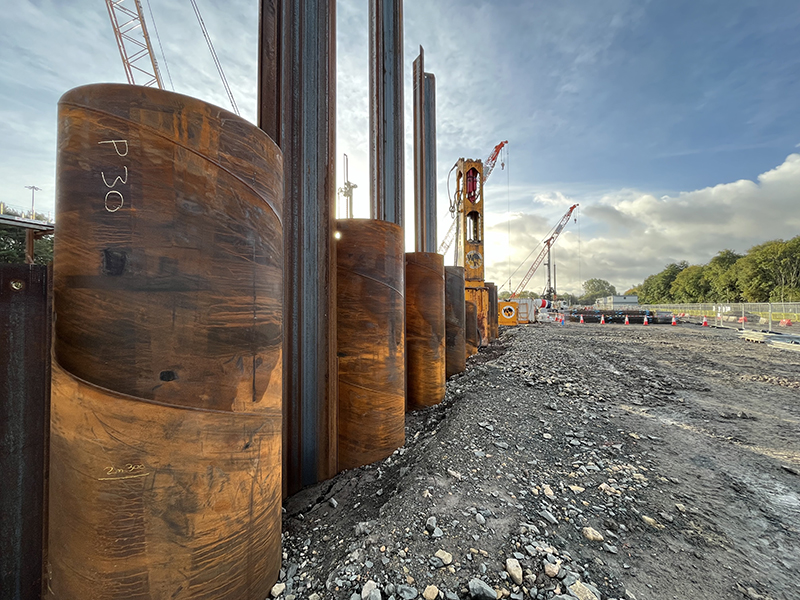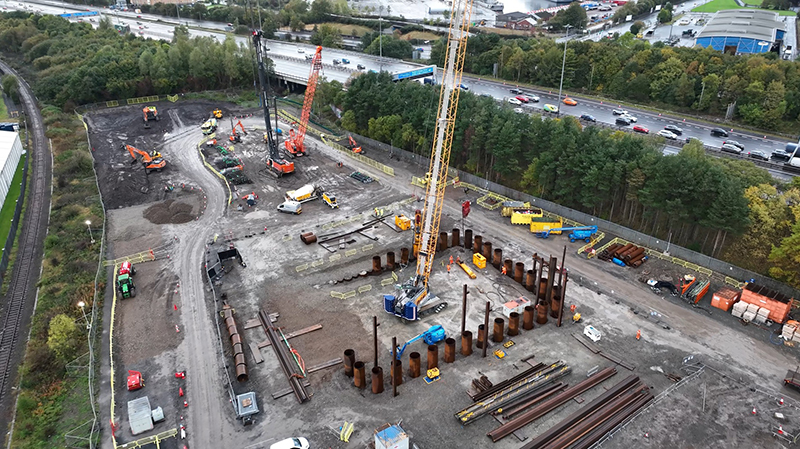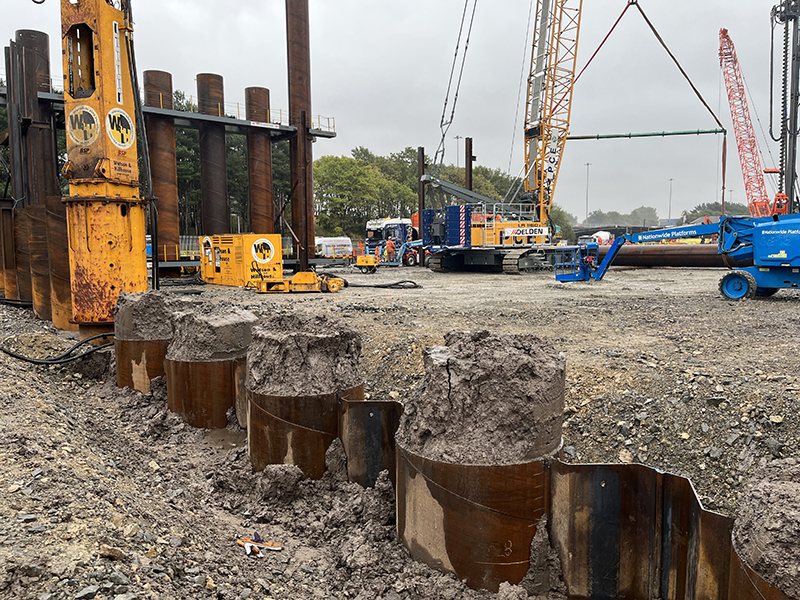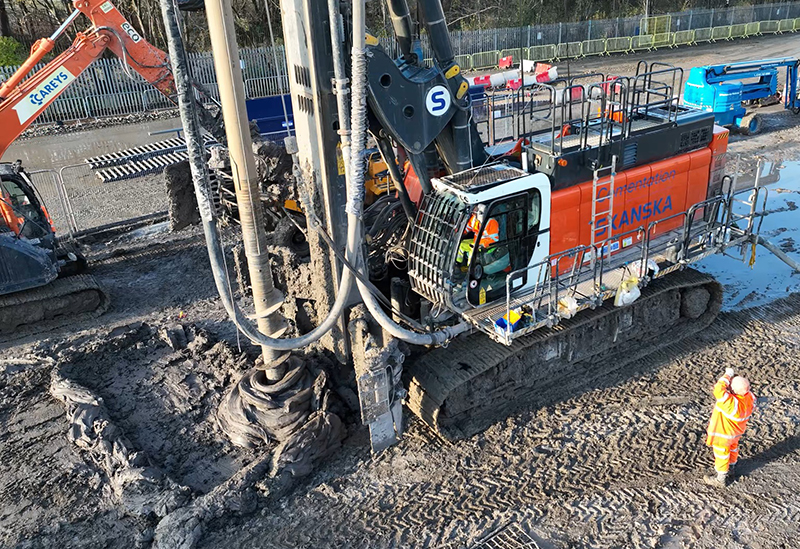
THE South Clyde Energy Centre on the outskirts of Glasgow is an energy-from-waste facility which will divert up to 350,000 tonnes of residual, non-recyclable waste away from landfill each year and generate enough electricity to power the equivalent of up to 70,000 homes. It will play a critical role in helping the Scottish Government meet its commitment to stop biodegradable waste being sent to landfill.
Construction began early last year with the site preparations and continued in July with the piling and ground engineering works. The company Fortum Glasgow Ltd, owned by Fortum (Fortum Recycling & Waste) and GIG (Green Investment Group) appointed Skanska’s piling and ground engineering business Cementation Skanska to design and construct the deep foundations for the state-of-the-art facility. The project is Cementation Skanska’s largest piling project in Scotland since the business began over a century ago.
Cementation Skanska entered into a NEC3 Option B contract with Fortum Glasgow Ltd. This type of contract, in which the works are priced on a bill of quantities (a detailed list of all the items of work required) is designed to provide greater clarity on costs and responsibilities for both parties.

By working together, Cementation Skanska has been able to provide Fortum Glasgow Ltd with greater cost certainty and transparency, along with an effective system for managing changes. These steps have made handling the contract simpler for everyone involved.
“At tender stage the piling design hadn’t been finalised, so an NEC3 Option B contract model worked really well for Fortum whilst still finalising the design,” explained Emma Haddow, Cementation Skanska’s Scotland director. “It meant that different design options could be considered, with clear visibility on what that would mean in terms of cost.”
Ilkka Toijala, head of Fortum UK, added, “The parties conducted multiple value engineering workshops together to optimise the design concept and ensure the most advanced techno-economic outcome without compromising complex technical requirements. The result has been successful in meeting the design criteria.”

Ground conditions at the site are particularly challenging with variable rock strengths and levels, along with a layer of alluvium, a soft loose sediment.
To combat the issues associated with this, the Cementation team developed a number of innovative solutions to stabilise the ground, ready for construction of the piles. For the bearing piles, rotary bored piles under bentonite support fluid were used as well as CFA (Continuous Flight Auger) piles, an installation method that involves drilling and concreting in one pass, for piles of up to 34m in length.
Using the CFA and rotary piling techniques, along with driven steel sheet piles and steel tubular piles for the combi (watertight) wall, has enabled the team to have already installed over 900 of the total 1,400 piles.

A bunker needed in the centre of the site required design and installation of a combi wall – which is more rigid and can withstand greater lateral forces than a traditional secant wall. The combi wall installation removed the need for extra temporary works, so the bunker can be excavated without propping supports.
Emma Haddow added, “Glasgow, like so many parts of Scotland, has particularly challenging ground conditions. Through being involved early on, we were able to provide technical advice and develop solutions that have enabled Fortum to create a scheme that met their ambitions, at the right price and timescale.
“At peak, we will have four rigs running with skilled crews constructing piles under bentonite support fluid and CFA at depths of up to 35m with diameters of up to 1350mm.”

The team is spearheading a number of innovations and new techniques. One trial will gather data using CemOptics, a thermal integrity profiling technique that has been developed in-house. CemOptics fibre cables will be installed in skeleton cages with purposely placed soil inclusions such as rocks and debris. The results will be analysed to assess how effectively and accurately CemOptics can detect defects and contaminations in piles.
The aim is to improve health and safety by replacing the traditional cross-hole sonic logging technique with CemOptics, which is a much safer method.
CemOptics is also being used to monitor the strain on the combi wall during the excavation process and to analyse the performance of the piles. In addition, the team plan to install a sacrificial test pile and anchors, installed under Polymer support fluid, close to a working bentonite test pile to better understand the product, its benefits in the area and compare test results between both piles.
Drones are also being used to carry out inspections of the rig masts to help pre-plan required works, avoiding the need for site teams to work at height.
“This has been a brilliant project to work on and one where some recent graduates have been able to start their careers,” Emma said. “It’s been a fantastic experience for them, and we are delighted to have played our part in supporting a cleaner future for Glasgow city.”
Ilkka Toijala added, “Fortum Glasgow Ltd is pleased about Skanska’s performance and close collaboration during the works.”
The South Clyde Energy Centre is an Energy-from-Waste Facility (EfW) that is jointly owned by Fortum (Fortum Recycling & Waste) and Green Investment Group, in Glasgow, Scotland.
The facility will be commissioned in 2026. It will generate energy from non-hazardous domestic and commercial waste left over from the recycling process.











